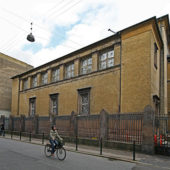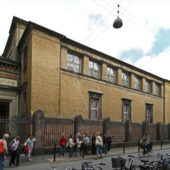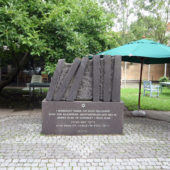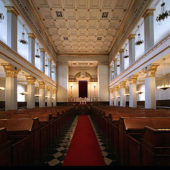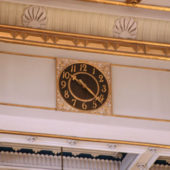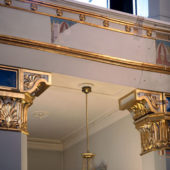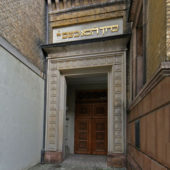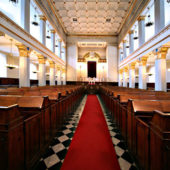One of a few synagogues of its period to use Egyptian elements in the columns, ceiling and cornice over the ark.
With its yellow brick exterior, the Great Synagogue of Copenhagen distinguishes itself from its immediate urban surroundings through color if not necessarily through architectural flamboyance.
In 1833 when the synagogue was built according to plans by celebrated Danish architect, Gustav Friedrich Hetsch (1788-1864), the neoclassical style was enjoying a renaissance in Europe and that certainly is reflected in the synagogue’s relative simplicity and clean external lines.
The theme continues in the interior, but with notable embellishments that, interestingly, highlight Egyptian details that give the synagogue a more eastern, rather than northern European feel. These details can be seen in the trapezoidal window shapes, the door openings and coved cornices over the ark.
The spacious interior, with its wood paneling and benches, accommodates up to 650 worshippers, with separate areas for men and women. The white walls and gold flourishes offset the dark wood. The ceiling, following the classical style, is coffered, adding more texture to an interior that remains cohesive in spite of competing styles.
The contrasts readily apparent in the synagogue’s architecture may very well reflect the stark and often divisive contrasts afflicting Copenhagen’s Jewish community preceding the time of the Great Synagogue’s construction.
Previously, the majority of the city’s small Jewish population of about 1,500 worshipped in a synagogue constructed in 1766 but which burned down in 1795. Though most of Copenhagen’s Jews were of Ashkenazic origin, there was a split between the more orthodox members and more progressive members of the congregation. As a result of this rift, the community did not rebuild the synagogue and members of the varying factions met in homes instead for their religious observances. The rift was partially overcome three decades later allowing for the current building to be constructed.
Jews first arrived in Denmark in 1622 at the invitation of Denmark’s King, thus becoming the first Jews in Scandinavia. They prospered in relative freedom though the population never grew to more than a few thousand. By 1812, Danish Jews were accorded civic equality and in 1849 they acquired full citizenship rights in Denmark.
While the Germans quickly occupied Denmark in WWII, Danish Jews enjoyed protection until 1943, when the Nazis demanded they be handed over. Instead, the Danish resistance mounted a mostly successful evacuation of the nation’s Jews to neutral Sweden across the Baltic Sea. A few Jews were captured and sent to Theresienstadt in Czechoslovakia where about 49 perished. A memorial to them and other victims of the Holocaust is located at the Great Synagogue. During the war, the Torah Scrolls from the synagogue were hidden in the Trinitatis Church and returned after the conflict. Likewise, most of Copenhagen’s Jews returned to the city after the war.
Today, the synagogue remains active, hosting community events, weddings, bar mitzvahs and regular worship services. A Hebrew inscription over the entrance beckons still to Copenhagen’s Jews: “Welcome in the name of God.”

